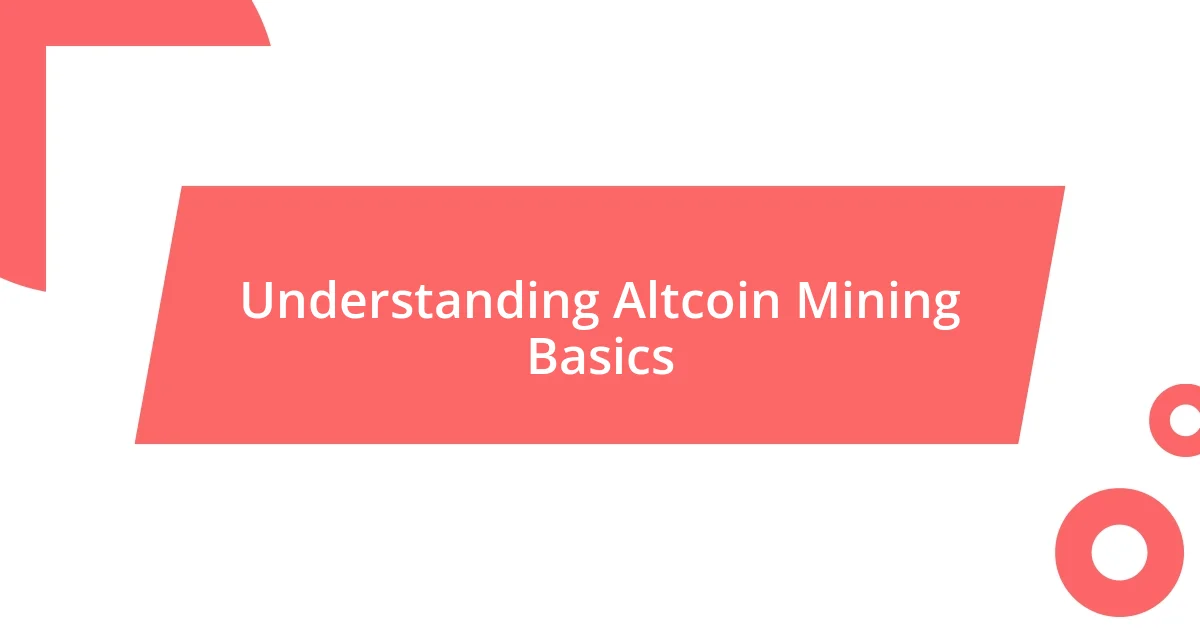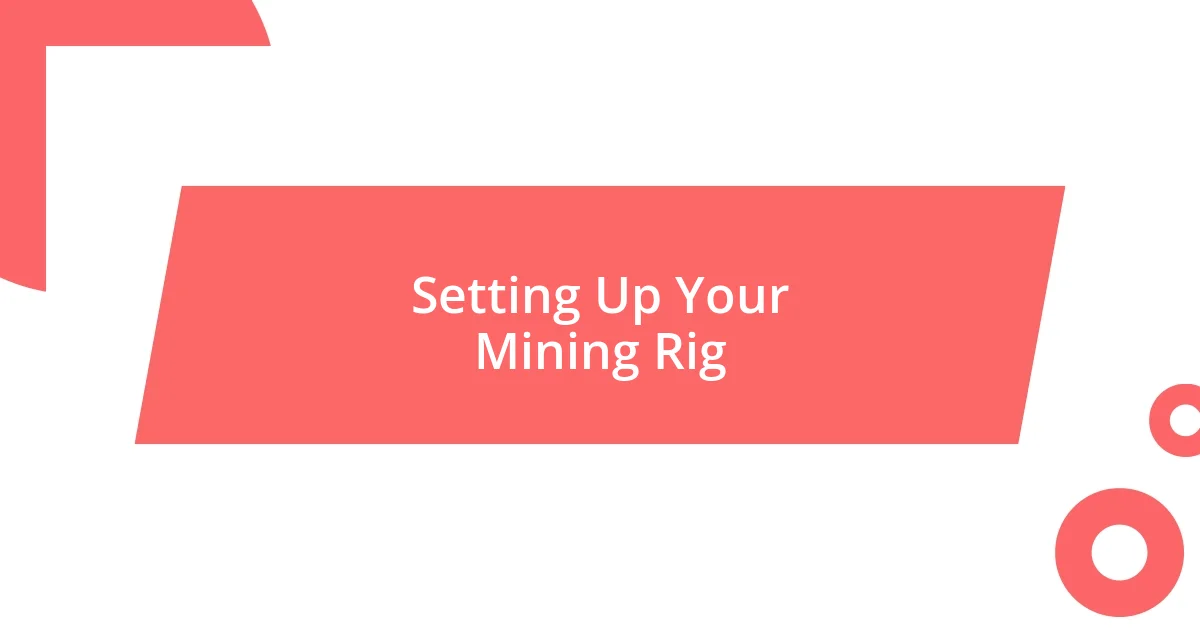Key takeaways:
- Understand different mining algorithms (proof of work vs proof of stake) and select altcoins based on their purpose, market potential, and community support.
- Set up a mining rig with the right components, ensure optimal cooling, and use suitable mining software to maximize efficiency and performance.
- Track profitability using calculators and spreadsheets, while staying updated on industry trends and community insights to adapt your mining strategy effectively.

Understanding Altcoin Mining Basics
Altcoin mining refers to the process of validating transactions and adding them to a blockchain for various alternative cryptocurrencies, or altcoins. When I first ventured into altcoin mining, I was struck by the sheer variety of coins available. Each project comes with its distinct features and mining algorithms, and understanding these nuances sparked my curiosity even more.
For me, one of the most fascinating aspects was the choice between proof of work and proof of stake. Proof of work requires miners to solve complex mathematical problems, while proof of stake allows coin holders to validate transactions based on the number of coins they own. I often found myself asking, which approach is truly the best? My experience taught me that there isn’t a one-size-fits-all answer; it largely depends on what goals you have and the resources at your disposal.
Getting started with mining can seem overwhelming, but breaking it down into steps can make it manageable. I vividly remember my first successful mining session; the thrill I felt when I saw my first block reward. It’s a captivating blend of technology and community, where each miner contributes to a shared goal—securing and growing the network. Isn’t it invigorating to be part of something so dynamic?

Choosing the Right Altcoins
When choosing the right altcoins, I found it essential to evaluate each coin’s purpose and technology. Not all altcoins are created equal; some have solid use cases and community backing, while others may lack direction. For instance, I once invested in a coin that promised revolutionary technology, only to see it fizzle out due to poor execution. It was a stark reminder that understanding the project’s fundamentals really matters.
Another critical factor is market potential. I remember analyzing various projects and how their market caps compared to Bitcoin. Some altcoins with lower market caps seemed poised for growth, making them attractive investments. However, I’ve learned to tread carefully; low market cap coins can also be more volatile, emphasizing the importance of conducting thorough research before diving in.
Lastly, community support and developer activity play significant roles in an altcoin’s longevity. I’ve joined numerous online forums where passionate advocates of specific coins share insights and updates. Observing the level of engagement and discussions often gives me clues about a project’s future. Ask yourself: does the community seem vibrant and active? If the answer is yes, it can indicate a healthier investment opportunity.
| Criteria | Importance |
|---|---|
| Project Purpose | Understanding the reason behind the coin’s existence aids in making informed decisions. |
| Market Potential | Evaluating market cap helps gauge growth opportunities but may indicate higher risk. |
| Community Support | A strong, active community often correlates with the coin’s success and development activity. |

Setting Up Your Mining Rig
Setting up your mining rig requires careful planning and the right components to ensure you’re optimally equipped. I still remember the excitement I felt as I gathered each piece, almost like assembling a puzzle that would unlock the world of altcoin mining for me. It’s essential to choose components that match your mining goals—whether you’re going for maximum efficiency or trying to push for higher hash rates.
Here are the key components you’ll need:
- Graphics Processing Unit (GPU): The heart of your rig; select a GPU that’s known for high performance in mining.
- Motherboard: Ensure it’s compatible with multiple GPUs and has enough slots for future upgrades.
- Processor (CPU): While not as crucial for mining, a decent CPU is essential for system stability.
- Power Supply Unit (PSU): Choose a reliable and efficient PSU to handle the power needs of your GPUs.
- Cooling System: Proper cooling is vital; excessive heat can damage components and slow performance.
- Mining Software: Select the right software that supports the coins you wish to mine; finding the best fit can make all the difference.
- Miner Frame: A sturdy frame or rig to hold everything together, allowing airflow for cooling.
As I set up my own rig, the thrill of watching all the components come together was electrifying. I meticulously arranged the cables, ensuring everything looked neat and functional. It felt like creating something valuable, a tangible investment in my newfound hobby. Each step brought me closer to the exhilarating moment of starting my first mining session, and the anticipation was simply unbeatable.

Mining Software and Tools
Navigating the realm of mining software can feel overwhelming at first, but it’s genuinely where the magic happens. I still recall my initial experience with different mining programs; it felt like being a chef in a kitchen filled with unique spices, each adding a distinct flavor to my mining results. For instance, I favored software like CGMiner and EasyMiner for their user-friendly interfaces and versatility, which allowed me to experiment with various altcoins without any headaches.
Once I settled on my mining software, I eagerly dived into the settings. You know that satisfying moment when everything clicks? I found tuning parameters like clock speed and fan speed to optimize my rig for the best performance thrilling. It’s essential to be comfortable with your software’s configuration options, as these adjustments can drastically impact your mining efficiency. Ask yourself: are you leaning into the technical challenges, or are they intimidating? Embracing the customization process not only enhances your results but also deepens your understanding of how mining works.
It’s also crucial to keep an eye on software updates and community feedback. I once missed a critical update that introduced enhanced features and bug fixes, and it starkly reminded me of the importance of staying proactive. Joining mining forums or following development channels can be incredibly beneficial. I found these discussions enriching as they often lead to tips and tricks that I had never considered, like using mining pools for consistent earnings. The sense of camaraderie in those communities constantly reinforces that I’m not just mining; I’m part of a dynamic ecosystem where everyone is eager to learn and share.

Optimizing Mining Performance
Optimizing mining performance is all about finding that sweet spot between efficiency and productivity. I remember when I first adjusted my GPU settings; it felt like tuning a musical instrument. The thrill of seeing improved hash rates as I slightly increased the clock speed was incredibly satisfying. Have you ever experienced that rush when a tweak leads to instant rewards? It’s exhilarating and keeps you engaged in the process.
Cooling solutions can’t be overlooked either—trust me, I’ve seen the consequences of neglecting them. When I first started, I skimped on fans, thinking it wouldn’t make a difference. I quickly learned that without proper airflow, my rig struggled, leading to reduced performance and even crashes. Investing in high-quality cooling systems was a game changer for my mining efficiency. It’s about creating a stable environment where your equipment can truly thrive.
Lastly, I’ve found that keeping a close eye on energy costs plays a vital role in optimizing performance. At first, I was so focused on my hash rates that I didn’t consider how much electricity I consumed. After reviewing my bills, I realized that tweaking settings for better energy efficiency not only improved my profits but also elongated my gear’s lifespan. Have you thought about how your mining setup impacts your wallet beyond just crypto returns? Balancing performance and costs ultimately led to a more sustainable and enjoyable mining experience for me.

Tracking Your Mining Profitability
Keeping tabs on your mining profitability can be a bit of a juggling act, but I’ve found it’s essential for staying on top of my investments. When I started, I kept a simple spreadsheet where I recorded my daily mining yields alongside electricity costs, just to see how the numbers danced in real-time. Have you ever felt that thrill when you realize your efforts are really paying off? It’s rewarding, to say the least, especially when the prices of the altcoins you’re mining start to rise.
Another tool that has saved me countless hours is mining profitability calculators. Over time, I learned which metrics mattered most, such as hash rate, energy consumption, and current coin price. I remember the first time I used one of these calculators; it felt like I had a crystal ball, shedding light on my potential profits. Wouldn’t it be great to know if a particular altcoin is worth your time before you dive in? By using these calculators, I gained insight into whether my mining was genuinely worth the effort or if I needed to shift my focus.
On a more personal note, I’ve had days when my earnings were impressive but realized that I’d overlooked certain costs, like pool fees and hardware depreciation. It’s a sobering moment that reminds me to factor in all moving parts of my operation. Have you ever been caught off guard by hidden expenses? I certainly have. This realization pushed me to adopt a more holistic view of profitability, ensuring that every aspect of my mining journey was aligned for optimal success.

Staying Updated on Industry Trends
Staying updated on industry trends is one of those essential practices that can make or break your altcoin mining experience. I remember stumbling across a specialized forum where enthusiasts discussed the latest developments in blockchain technology. Engaging in those conversations not only expanded my knowledge but also opened doors to new mining opportunities. Have you ever felt like being part of a community gave you a competitive edge? It truly does—sharing insights and learning from others’ experiences builds a foundation for success.
Subscribing to reputable newsletters and following industry experts on social media also keeps me in the loop. I often find myself refreshing my feed, eager to read about the latest algorithm changes or upcoming altcoin launches. It’s fascinating to see how quickly things evolve in the crypto space. Have you noticed how one piece of information can tilt the balance between profit and loss in mining? That’s why being proactive in gathering information is crucial—I’ve learned that the more I know, the better positioned I am to adapt and thrive in this fast-paced environment.
I’ve also learned to attend webinars and online conferences, which offer incredible insights directly from industry leaders. The first time I attended a live Q&A session, I was amazed by the depth of knowledge shared and the innovative strategies discussed. Those interactions sparked new ideas in my mining approach. Isn’t it rewarding to gain insights that not only inform but also inspire you to refine your strategy? Keeping current isn’t just about knowledge; it’s about motivation and finding renewed purpose in your altcoin mining journey.















